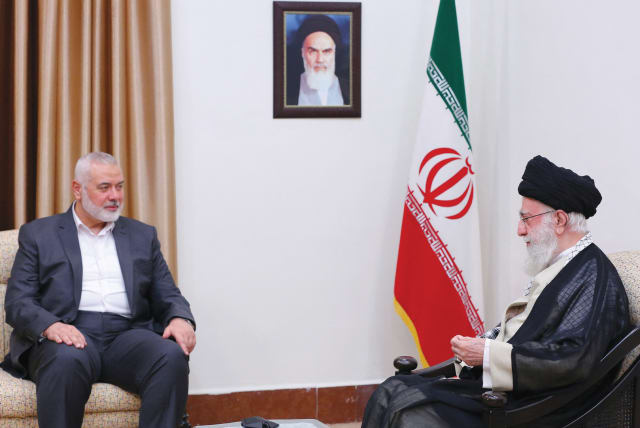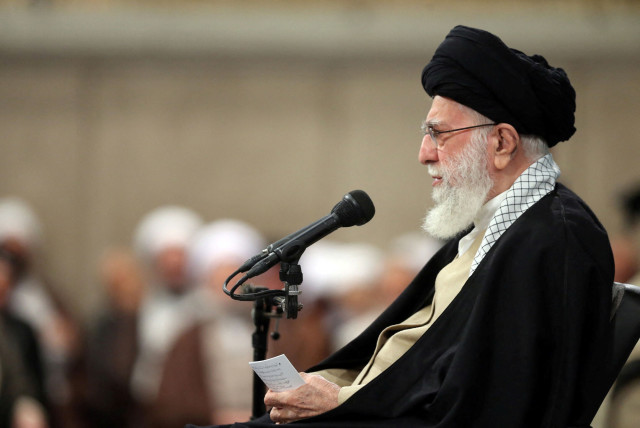Iran and Hamas terrorism: The complex interplay of the Middle East quagmire - opinion

The effects of the Arab conquest, lasting from 632 to 654 CE, rippled through the annals of history, shaping the geopolitical and cultural dynamics of the region.
In the contemporary global landscape, inundated with vivid images and unfolding events from the heart of the Middle East, I find my thoughts being drawn back to the tumultuous history of Iran. The historical events that unfolded in Iran echo the challenges faced by this region in confronting aggression and the evolving interplay of state-sponsored terrorism.
The Arab conquest of Iran during the Rashidun Caliphate marked a significant turning point, leading to the decline of the once mighty Sasanian Empire and the diminishing influence of Zoroastrianism. The effects of this conquest, lasting from 632 to 654 CE, rippled through the annals of history, shaping the geopolitical and cultural dynamics of the region.
Fast-forward to 1979, a year that bore witness to a seismic shift in Iran’s political landscape. This marked the rise of Shia radical mullahs to power, bolstered by a transnational terrorist network. Under Khomeini’s leadership, a Shia Islamic caliphate was established in Tehran. This transformation went largely unnoticed by the global community, their attention elsewhere as events of monumental consequence unfolded.
It’s crucial to revisit the events leading up to the rise of the current regime in Iran. The international community expressed praise for Khomeini at a time when the seeds of a radical revolution were being sown. This appreciation and miscalculation from the global powers compounded the challenges the Middle East faces today.
Months before any potential ransom from US President Joe Biden, the Iranian regime was already plotting a terrorist attack, evident from consistent communication and meetings with various terrorist groups. The regime openly discussed the annihilation of Israel, but the world seemed oblivious, displaying a lack of awareness regarding the deceptive strategies employed by Islamic caliphates.
Today, the alignment of Hamas terrorists with Iran and its proxies has become abundantly clear. Iranian officials’ celebration of terrorist attacks underscores their unwavering support for terrorism and violence against innocent civilians. The ominous shadows of these actions cast a dark pall over the region, reminding us of the urgent need for strategic vigilance.
However, the Middle East, a mosaic of cultures and ideologies, has become a battleground where conflicting beliefs and political interests collide. Iran and Turkey, among other states, actively support Hamas and its terrorist activities, fueling a perpetual cycle of violence. It is crucial not to underestimate their animosity toward Israel and their strategic involvement in the region, as this forms the crux of the present discord.
The international community, tasked with preserving peace and stability in the region, should critically reevaluate its approach. Endorsing a regime change in Tehran could serve as a cornerstone for a more stable and peaceful Middle East. Focusing on targeting the root cause of the problem rather than engaging in armed conflicts should take precedence in the pursuit of lasting peace.
Recent terrorist attacks on Israel serve as a grim reminder of the “Palestinian ideal,” a notion that has been used as a tool for furthering an agenda of violence and deception. Unfortunately, some factions defend this ideal, aligning it with the Islamic Republic, Islamic State, and the Taliban. The Palestinian issue, ostensibly a struggle for justice, has been tainted, morphing into a platform for barbarity and malignant influence.
Iran’s aggressive pursuits and ruthless ideology pose a significant threat to peace and humanitarian values in the Middle East. Israel’s efforts to neutralize terrorist proxies orchestrated by the Islamic Revolutionary Guard Corps’ extraterritorial branch Quds Force underscore its commitment to ensuring safety and security in the region. However, these actions are merely responses to a much larger and entrenched issue – the interplay of state-sponsored terrorism.
The Iran-Hamas alliance and its impact on Israel’s conflict dynamics
The IRGC and its Quds Force play a pivotal role in shaping the dynamics of terrorism across the Middle East. The IRGC, founded after the 1979 revolution, has been instrumental in advancing the ideological and strategic goals of the Islamic Republic. Over the years, it has metamorphosed into a powerful entity with significant influence, not just within Iran but also beyond its borders.
Seeking to expand its influence and regional presence, Iran’s regime has provided Hamas with financial, military, and ideological support. This support includes the supply of weapons, training, and funding for Hamas’s activities in the Gaza Strip, which is a major flashpoint in the Israeli-Palestinian conflict. Iran views Hamas as a strategic partner to further its anti-Israel agenda and project influence in the Middle East.
Hamas, on the other hand, has found a reliable ally in Iran, gaining access to resources and capabilities that enhance its ability to challenge Israel. The alliance empowers Hamas to pursue its goals more assertively, often through acts of violence against Israel. Iran’s backing strengthens Hamas’s military capabilities, enabling it to launch rockets and carry out attacks on Israeli territories, thereby escalating the conflict.
The IRGC oversees and supports various paramilitary groups, like Hezbollah in Lebanon and Shia militias in Iraq and Syria. Its activities are not confined to a particular region; instead, they reverberate across the Middle East. The Quds Force’s modus operandi includes supporting and arming non-state actors, furthering Iran’s interests and influence in the region.
Understanding the intricate interplay of the IRGC and the Quds Force is paramount in comprehending the pervasive influence of state-sponsored terrorism. These entities utilize both direct and indirect approaches to further Iran’s agenda, encompassing ideological, political, and strategic objectives.
In conclusion, Iran, alongside Qatar and Turkey, plays a significant role in supporting Hamas and shaping its agenda. These actions represent a complex interplay of politics and terrorism, underscoring the need for a comprehensive understanding of the region’s dynamics. Addressing the core issue in Tehran and concurrently working toward eradicating the terrorist presence in the Gaza Strip is imperative to establish peace and stability.
These terrorist actions by Hamas, often with Iran’s indirect or direct support, can trigger Israeli responses, leading to an escalation of violence and potential conflicts in the region. The Israel-Hamas conflict has a long history, with each party responding to perceived threats and provocations from the other, further entrenching the cycle of violence.
The Iran-Hamas alliance significantly affects the conflict dynamics in the region, potentially fueling tensions and conflicts between Israel and Hamas. Iran’s support empowers Hamas and contributes to the ongoing volatility in the Israeli-Palestinian conflict, which could lead to escalated violence and military engagements.
The writer is a counterterrorism analyst and Middle East studies researcher based in Washington. He is a Jewish Kurd of Iran and the author of The Gruesome Mullah. See more at www.erfanfard.com.
Jerusalem Post Store
`; document.getElementById("linkPremium").innerHTML = cont; var divWithLink = document.getElementById("premium-link"); if (divWithLink !== null && divWithLink !== 'undefined') { divWithLink.style.border = "solid 1px #cb0f3e"; divWithLink.style.textAlign = "center"; divWithLink.style.marginBottom = "15px"; divWithLink.style.marginTop = "15px"; divWithLink.style.width = "100%"; divWithLink.style.backgroundColor = "#122952"; divWithLink.style.color = "#ffffff"; divWithLink.style.lineHeight = "1.5"; } } (function (v, i) { });

